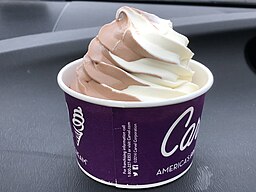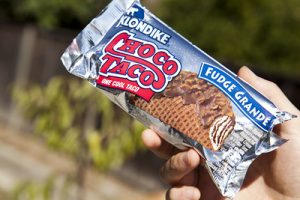The most likely precursors to today’s ice cream came from various places in Asia. During the Tang Dynasty (618-907 AD) in China, a recipe for ice cream was known by the royal house. This early ice cream, opens a new window was made by heating buffalo milk with flour, flavoring with an aromatic substance called camphor, and lowering the mixture into tubes into an icy pool to freeze it. It is similar to and likely would have tasted more like the traditional Indian dessert kulfi than modern Western ice cream. An ancestor of sherbets and sorbets that became popular in the Western world is sharbat, opens a new window, a chilled drink that originated in Iran, formerly known as Persia. Sharbat is often served in liquid form and is flavored with fruit, herbs, and flower petals. Although some types of sharbat use milk for flavoring, the milk is often not frozen in the manner of ice cream.
Popular history often cites people already noteworthy with introducing ice cream to Europe; claims that Marco Polo brought back the recipe from China or that Charles I, opens a new window of England had a secret ice cream recipe are undocumented and most likely legends. The first documented cases of “ice cream” appear in European countries from the mid-1600s onward, long after Marco Polo’s journeys. The actual creator of modern ice cream was most likely Procopio Cutò, opens a new window, a Sicilian man who became the first acclaimed ice cream chef. Cutò was inspired by sorbet, opens a new window, a frozen Italian dessert derived from the Persian sharbat. He used his grandfather’s sorbet machine, but made a crucial change to the recipe. He replaced the honey used to flavor the sorbet with sugar and added salt to make the ice melt more slowly, allowing the cream to freeze. Cutò opened his store, Café Procope, in 1686, and it was conveniently located near France’s greatest theatre, the Comédie-Française. Cutò’s gelato became popular among France’s cultural elite and greatest intellectuals, and his creation was so acclaimed that King Louis XIV granted Cutò a royal license, making him the only gelato producer in all of France. Café Procope had such an incredible impact on French culture that a restaurant exists in its historical location to this day.
Joy for the Masses: How Ice Cream Went Mainstream
It would take many decades before ice cream would go from a delicacy enjoyed by royalty and the wealthy elite to a wider slice of the population. Ice cream had been available in the New World since before the founding of the United States; an early reference can be found in 1744, noted by a guest of Maryland governor William Bladen, opens a new window. But it was still expensive and difficult for most people to obtain. C. Jacob Fussell, opens a new window, a Quaker from Maryland, was an early pioneer in reducing the cost of ice cream. He created the first commercial ice cream factory in the world, choosing York County, Pennsylvania, as his base of operations in 1852, later moving to Baltimore. He was able to produce ice cream at 25 cents a quart, underselling his rivals who typically sold at 60 cents a quart.
In the United Kingdom, another great innovator appeared. Agnes Marshall, opens a new window was a cook who had ingenious recipes for ice cream and other foods, but perhaps her greatest invention was the ice cream cone. She called her cones “cornets” and made them from ground almonds. This freed her from having to serve ice cream in glasses that would have to be returned and washed after each customer used them. Innovative and industrious, she created the Marshall’s Patent Freezer, opens a new window, a machine that could freeze a pint of ice cream in less than five minutes. Marshall also created and ran the Marshall’s School of Cookery, opens a new window in London, where she taught courses and sold the freezers and refrigerators she had designed. She was a driven entrepreneur and published her first book, The Book of Ices,, opens a new window in 1885, and then began to go on lecture tours to publicize her recipes and ideas starting in 1891. It was Agnes Marshall who brought the joy of ice cream to the British middle class.
Two more innovations from the late 19th century would further fuel the expansion of ice cream’s popularity. The first to arrive was the ice cream float during the 1870s. Several people are credited with creating the first ice cream float; the one most typically credited is Robert McCay Green, opens a new window, a manufacturer of soda fountains. His version of the invention was that he intentionally mixed ice cream with his soda to try to draw attention away from a rival’s newer soda fountain. At least 3 other people claim to have invented the ice cream float, including George Guy, opens a new window. Guy supposedly invented the float by accidentally dropping ice cream into a soda order, delighting a customer who tasted the result.
The ice cream sundae followed shortly after, about a decade to two decades later. It has never been agreed upon where the sundae originated, although the two cities, opens a new window with the strongest rivalry over the claim are Ithaca, New York, and Two Rivers, Wisconsin. Famed satirist H.L. Mencken believed that Two Rivers was where the sundae was invented, and popularized a story that it had been invented as a special treat for Sundays only to get around the religious laws of the time that prohibited serving soda on Sundays. However, Mencken’s account was based on a popular story from Wisconsin and could not be absolutely verified.
The Rise of Ice Cream Trucks
The 20th century would bring with it the mass adoption of automobiles - and a way to get ice cream to customers much faster. Ice cream could now be shipped more easily to grocery stores – or to customers themselves with a special truck. The invention of the ice cream truck is credited to Harry Burt, opens a new window, the creator of the Good Humor ice cream brand. Burt’s truck had a built-in refrigeration unit, which both gave it an advantage over competitors’ pushcarts and allowed him to store ice cream easily at a time when most people did not have home refrigerators. As time went on, home refrigeration would become more common, but ice cream trucks would maintain a presence through ice cream treats. Burt himself began the trend with the Good Humor, opens a new window bars, originally vanilla ice cream coated with chocolate.
Another important invention from the first half of the 20th century was the creation of soft serve ice cream. This technique was popularized by Tom Carvel, opens a new window, the creator of the Carvel brand of ice cream cakes. In 1934, Carvel’s ice cream truck got a flat tire, so he pulled into a parking lot and sold the melting ice cream to travelers passing by. They reacted so enthusiastically that, by 1936, Carvel bought out the store in the parking lot he had pulled into, converted it into a new ice cream stand, and installed a machine that would recreate the melted ice cream texture. Soft serve machines became very important on submarines,, opens a new window as they were one of the very few comforts of home available on long voyages. Soft serve cannot be bought prepacked from grocery stores, as it typically requires very precise freezing conditions from the machine and a high volume of air (33 to 45 percent) for proper texture.
Many novelty ice cream products were needed to help ice cream trucks survive the soft-serve onslaught. One of the most ingenious of these was the Choco Taco, opens a new window, a waffle cone “taco shell” and chocolate topping covering vanilla ice cream in the center. It was created in 1983 by Alan Drazen, opens a new window, a former ice cream truck driver, in Philadelphia. Inspired by the rising popularity of Mexican food, Drazen devised a taco form for ice cream that would allow the eater to always get chocolate, vanilla, waffle cone, and nuts in one bite. This set the Choco Taco apart from earlier novelty cones and led to a rapid growth in its popularity, and it was even sold at some Taco Bell locations until 2015, opens a new window. Being an ice cream novelty, the Choco Taco was rarely available in grocery stores, making it a sought-after treat at the ice cream trucks and Taco Bells that offered it. Sadly, Klondike discontinued, opens a new window the Choco Taco in 2022; the sadness of generations that grew up in the 80s and 90s suggests that there may be a market for a return someday, or success from a similar product.
What wonderful ice cream will the future offer? You can try ice cream, both traditional and new, at locally owned ice cream shops, such as Carl’s and Tilly’s, opens a new window. If you’re even more adventurous, you can use CRRL’s collection of cookbooks, opens a new window to learn how to make interesting ice cream of your own.
Books all about ice cream!







